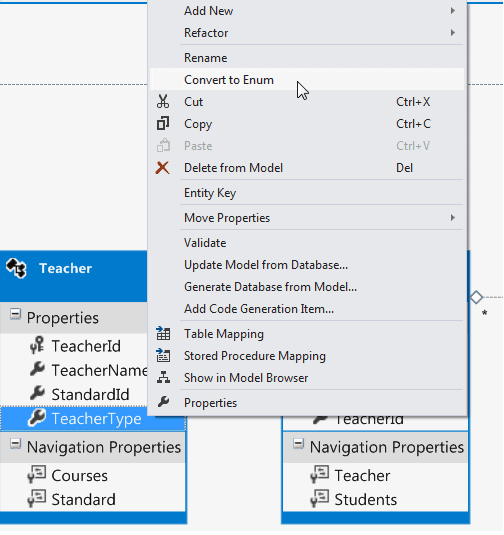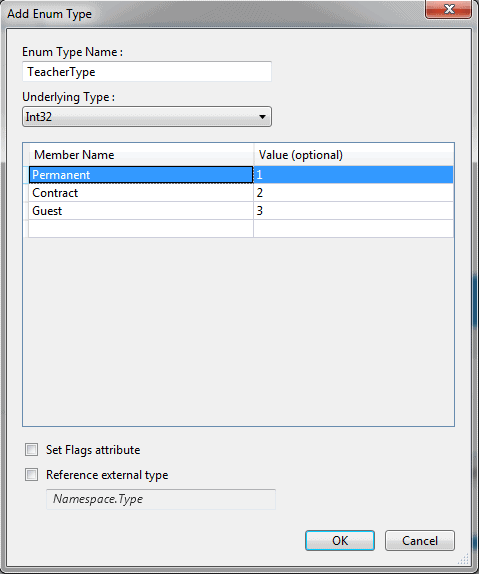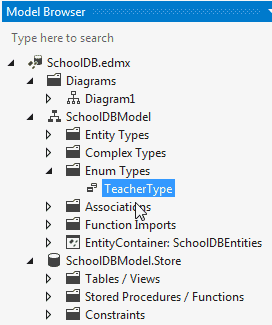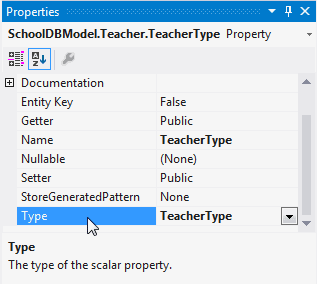Entity Framework Tutorial Basics(32):Enum Support
Enum in Entity Framework:
You can now have an Enum in Entity Framework 5.0 onwards. EF 5 should target .NET framework 4.5 in order to use Enum.
Enum can be created for the following data types:
- Int16
- Int32
- Int64
- Byte
- SByte
You can create and use an Enum type in your entity data model in three ways:
- Convert an existing property of entity to Enum from EDM designer
- Add a new Enum from EDM designer
- Use an existing Enum type from different namespace
For the purposes of this demo, we have included the TeacherType integer column in the Teacher table of SchoolDB. TeacherType 1 is for permanent teachers, 2 is for contractor teachers, and 3 is for guest teachers.
1. Convert an existing property to Enum:
Next, we will see how to convert a TeacherType to an Enum.
First, right click on the TeacherType property of a Teacher entity and click 'Convert to Enum' in the context menu.
It will open the 'Add Enum Type' dialog box where you can enter the 'Enum Type Name' and, select 'Underlying Type' and Enum member names. For example:
After converting it to Enum, you can see TeacherType as Enum Type in the Model Browser, as shown below:
Also, you can see that the type of the TeacherType property is converted to TeacherType Enum:
Now, you can use TeacherType Enum in CRUD operation using DBContext. For example:
using (var ctx = new SchoolDBEntities())
{
Teacher tchr = new Teacher();
tchr.TeacherName = "New Teacher"; //assign enum value
tchr.TeacherType = TeacherType.Permanent; ctx.Teachers.Add(tchr); ctx.SaveChanges();
}
2. Add New Enum from Designer:
You can also add a new Enum by right clicking on EDM designer and selecting Add → Enum Type. It will open the same 'Add Enum Type' dialog box, where you can enter enum members.
After creating an Enum Type you can change the type of the TeacherType property to the newly created TeacherType Enum from the property window.
3. If you already have Enum type created in your code, then you can use that as a data type of any entity property.
To use an existing Enum type, right click on designer → Add New → Enum Type. Enter the Enum Type Name in the dialog box. Do not enter the member as you already have that in your code.
Now, select 'Reference external type' checkbox and enter the namespace of your existing enum and click OK. This will add the Enum type in the Model browser. Then, you can assign this Enum type to any property of an entity from the property window.
Note: Select 'Set Flags attribute' if you want to use bitwise operators with your Enum.
Entity Framework Tutorial Basics(32):Enum Support的更多相关文章
- Entity Framework Tutorial Basics(1):Introduction
以下系列文章为Entity Framework Turial Basics系列 http://www.entityframeworktutorial.net/EntityFramework5/enti ...
- Entity Framework Tutorial Basics(4):Setup Entity Framework Environment
Setup Entity Framework Environment: Entity Framework 5.0 API was distributed in two places, in NuGet ...
- Entity Framework Tutorial Basics(43):Download Sample Project
Download Sample Project: Download sample project for basic Entity Framework tutorials. Sample projec ...
- Entity Framework Tutorial Basics(42):Colored Entity
Colored Entity in Entity Framework 5.0 You can change the color of an entity in the designer so that ...
- Entity Framework Tutorial Basics(41):Multiple Diagrams
Multiple Diagrams in Entity Framework 5.0 Visual Studio 2012 provides a facility to split the design ...
- Entity Framework Tutorial Basics(37):Lazy Loading
Lazy Loading: One of the important functions of Entity Framework is lazy loading. Lazy loading means ...
- Entity Framework Tutorial Basics(36):Eager Loading
Eager Loading: Eager loading is the process whereby a query for one type of entity also loads relate ...
- Entity Framework Tutorial Basics(34):Table-Valued Function
Table-Valued Function in Entity Framework 5.0 Entity Framework 5.0 supports Table-valued functions o ...
- Entity Framework Tutorial Basics(33):Spatial Data type support in Entity Framework 5.0
Spatial Data type support in Entity Framework 5.0 MS SQL Server 2008 introduced two spatial data typ ...
随机推荐
- UVALive 3971 Assemble(二分+贪心)
本题思路不难,但是要快速准确的AC有点儿考验代码功力. 看了大白书上的标程,大有所获. 用map和vector的结合给输入分组,这个数据结构的使用非常精美,恰到好处. #include<iost ...
- 重构代码 —— 函数即变量(Replace temp with Query)
函数即变量,这里的函数指的是返回值为某一对象的函数.Replace temp with query,query 是一种查询函数. example 1 double price() { return t ...
- POJ2411Mondriaan's Dream(DP+状态压缩 or 插头DP)
问题: Squares and rectangles fascinated the famous Dutch painter Piet Mondriaan. One night, after prod ...
- Mycat 在vscode中的开发配置
mycat是国产目前最被追捧的一款分布式数据库集群软件,有一些公司对数据库和应用都有自己的集群方案,但是更多的是一些面对庞大的数据量,而束手无策. 对于这种问题,我想百分之80遇到的是数据库的瓶颈,所 ...
- [转]NME Android目标中文输入问题完美解决!
最近研究了一下haxe,发现蛮牛逼的,转几篇知识帖 haXe开发笔记:中文问题的小结 * .hx源文件中如果包含中文,要保存成UTF-8编码才能够正确被haXe编译器解析,是否包含BOM(Byte O ...
- PCBA 生产需要什么文件? (2018-07-10)
PCBA 生产需要什么文件? 生产需要资料 工单套料单 生产说明文件 生产贴片图 正面含元件号 背面含元件号 钢网资料(可以是 Gerber) 元件坐标图
- Oracle查询数据表结构(字段,类型,大小,备注)
作用:想要生成整个Oracle数据库所有表结构WORD文档(数据库设计说明书) Oracle数据库字典介绍 Oracle数据字典是有表和视图组成的,存储有关数据库结构信息的一些数据库对象.数据库 ...
- java代码异常篇
总结:掌握流.缓冲区类的方法 package com.b; import java.io.BufferedReader; import java.io.File; import java.io.Fil ...
- Celery-4.1 用户指南:Testing with Celery (用 Celery测试)
任务与单元测试 在单元测试中测试任务行为的推荐方法是用mocking. Eager mode: task_always_eager 设置启用的 eager 模式不适用于单元测试. 当使用eager模式 ...
- C Primer Plus学习笔记(五)- C控制语句:循环
伪代码的概念: 伪代码是一种用简单的句子表示程序思路的方法,它与计算机语言的形式相对应.伪代码有助于设计程序的逻辑.确定程序的逻辑无误之后,再把伪代码翻译成实际的编程代码.使用伪代码的好处之一是,可以 ...




